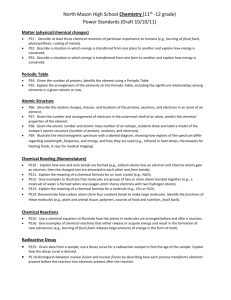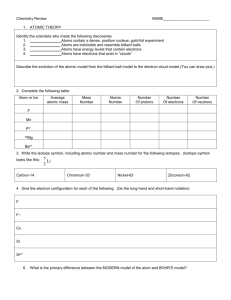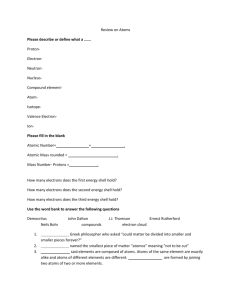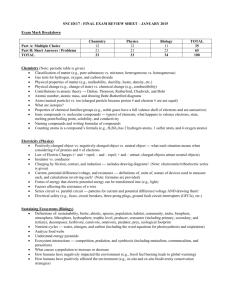DiscBio_C5_Voc
advertisement
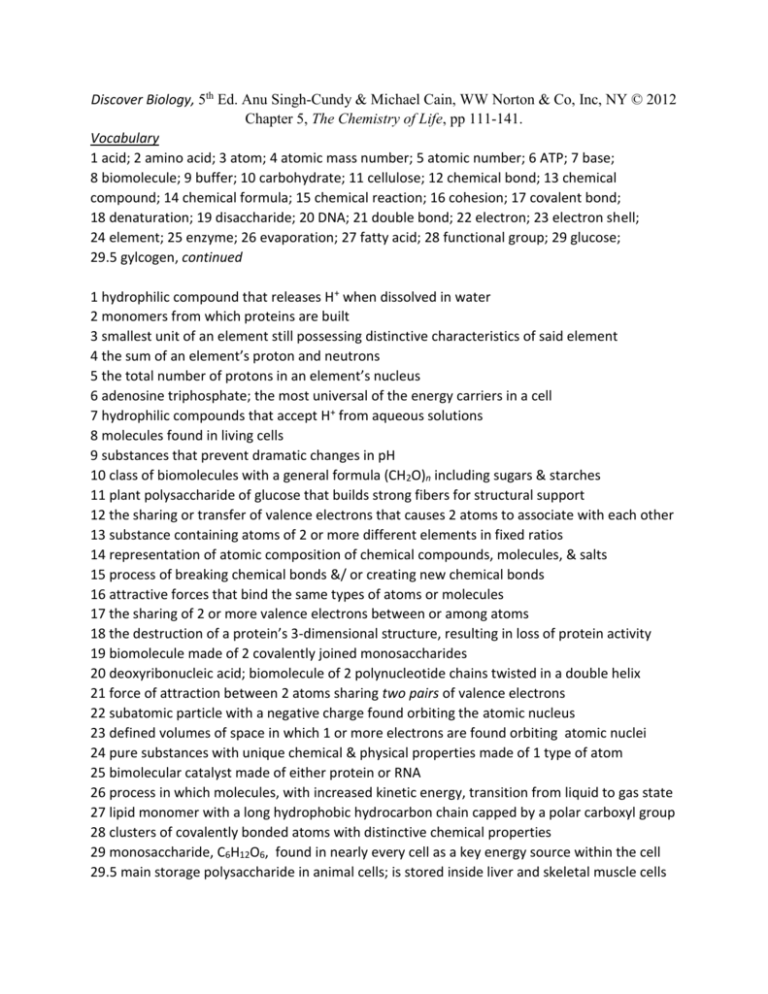
Discover Biology, 5th Ed. Anu Singh-Cundy & Michael Cain, WW Norton & Co, Inc, NY © 2012 Chapter 5, The Chemistry of Life, pp 111-141. Vocabulary 1 acid; 2 amino acid; 3 atom; 4 atomic mass number; 5 atomic number; 6 ATP; 7 base; 8 biomolecule; 9 buffer; 10 carbohydrate; 11 cellulose; 12 chemical bond; 13 chemical compound; 14 chemical formula; 15 chemical reaction; 16 cohesion; 17 covalent bond; 18 denaturation; 19 disaccharide; 20 DNA; 21 double bond; 22 electron; 23 electron shell; 24 element; 25 enzyme; 26 evaporation; 27 fatty acid; 28 functional group; 29 glucose; 29.5 gylcogen, continued 1 hydrophilic compound that releases H+ when dissolved in water 2 monomers from which proteins are built 3 smallest unit of an element still possessing distinctive characteristics of said element 4 the sum of an element’s proton and neutrons 5 the total number of protons in an element’s nucleus 6 adenosine triphosphate; the most universal of the energy carriers in a cell 7 hydrophilic compounds that accept H+ from aqueous solutions 8 molecules found in living cells 9 substances that prevent dramatic changes in pH 10 class of biomolecules with a general formula (CH2O)n including sugars & starches 11 plant polysaccharide of glucose that builds strong fibers for structural support 12 the sharing or transfer of valence electrons that causes 2 atoms to associate with each other 13 substance containing atoms of 2 or more different elements in fixed ratios 14 representation of atomic composition of chemical compounds, molecules, & salts 15 process of breaking chemical bonds &/ or creating new chemical bonds 16 attractive forces that bind the same types of atoms or molecules 17 the sharing of 2 or more valence electrons between or among atoms 18 the destruction of a protein’s 3-dimensional structure, resulting in loss of protein activity 19 biomolecule made of 2 covalently joined monosaccharides 20 deoxyribonucleic acid; biomolecule of 2 polynucleotide chains twisted in a double helix 21 force of attraction between 2 atoms sharing two pairs of valence electrons 22 subatomic particle with a negative charge found orbiting the atomic nucleus 23 defined volumes of space in which 1 or more electrons are found orbiting atomic nuclei 24 pure substances with unique chemical & physical properties made of 1 type of atom 25 bimolecular catalyst made of either protein or RNA 26 process in which molecules, with increased kinetic energy, transition from liquid to gas state 27 lipid monomer with a long hydrophobic hydrocarbon chain capped by a polar carboxyl group 28 clusters of covalently bonded atoms with distinctive chemical properties 29 monosaccharide, C6H12O6, found in nearly every cell as a key energy source within the cell 29.5 main storage polysaccharide in animal cells; is stored inside liver and skeletal muscle cells



